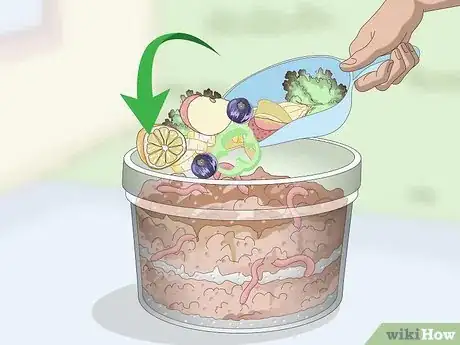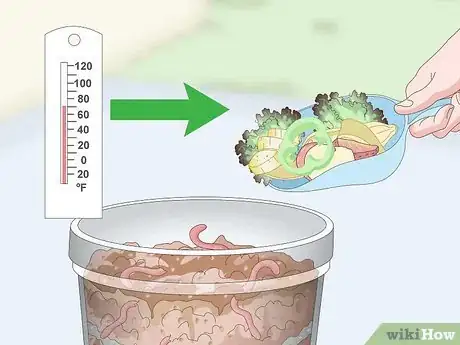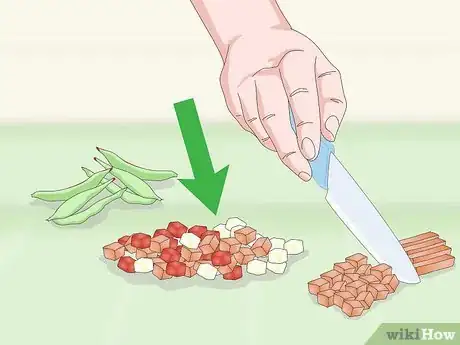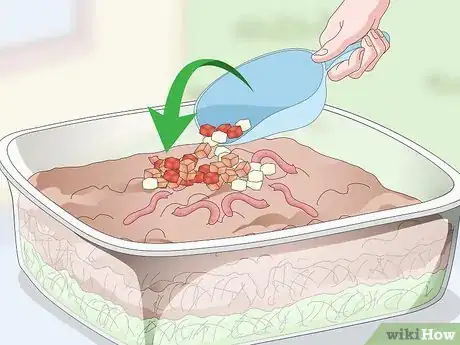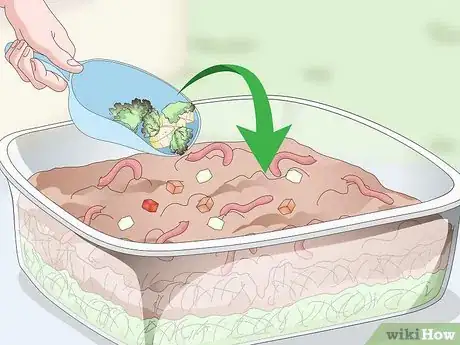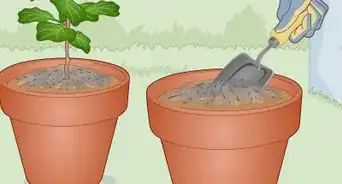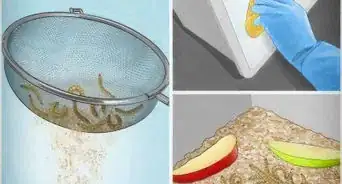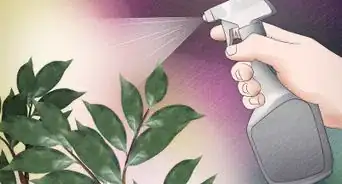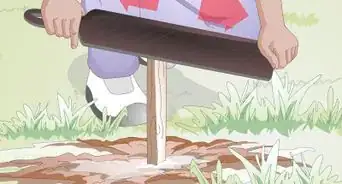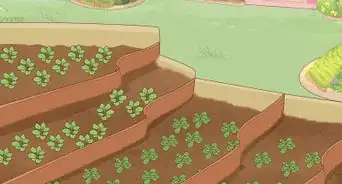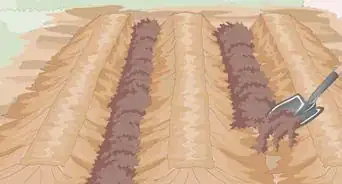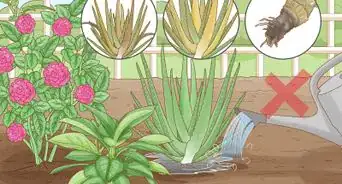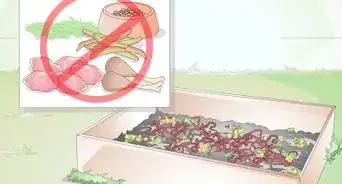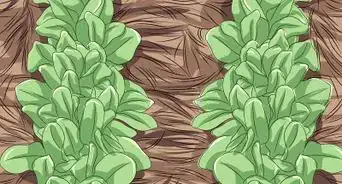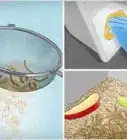This article was co-authored by Lauren Kurtz and by wikiHow staff writer, Sophia Latorre. Lauren Kurtz is a Naturalist and Horticultural Specialist. Lauren has worked for Aurora, Colorado managing the Water-Wise Garden at Aurora Municipal Center for the Water Conservation Department. She earned a BA in Environmental and Sustainability Studies from Western Michigan University in 2014.
wikiHow marks an article as reader-approved once it receives enough positive feedback. In this case, 98% of readers who voted found the article helpful, earning it our reader-approved status.
This article has been viewed 179,162 times.
Once you’ve set up a worm farm, you must provide your worms with the right kind of foods to ensure they thrive and remain healthy. Worms will eat many things, including fruits, vegetables, eggshells, coffee grounds, leaves, grass clippings, paper, and cardboard! However, there are also some foods you should avoid feeding your worms, like meat, grains, and dairy products. Watch your worms carefully to see what kinds of foods they like the best and how quickly they eat the food you provide them.
Steps
Choosing the Right Foods
-
1Feed your worms fruit and vegetable scraps. Worms will enjoy a variety of fruits and veggies, like bananas, pumpkin, apples, lettuces, eggplant, berries, squash, and greens. However, you should avoid feeding citrus fruits, including oranges, limes, lemons, and grapefruits, to your worms.[1]
- You can also add scraps from your juicer, as long as it doesn’t contain citrus fruits.
-
2Add eggshells and coffee grounds to the worm bin. Coffee grounds are a great addition to a worm bin as they are full of nitrogen and have a neutral pH. Egg shells are also quite beneficial as they provide calcium for your worms. Just make sure the eggshells are free of fats, like cooking oil or butter, before feeding them to your worms.[2]Advertisement
-
3Include hair, dust, wood ash, and sawdust. Pet and human hair, in addition to dust, like that which collects in a vacuum cleaner, can also be added to the worm bin. You can include wood ash, such as from a fireplace or smoker, as well as sawdust (from untreated wood), too.<
-
4Provide organic matter for bedding. Leaves, grass clippings, black peat, and coconut coir, in addition to shredded egg cartons, paper, tissues, paper towels, and cardboard are examples of good organic bedding choices that will break down and serve as a food source for your worms.[3]
- Be sure to soak cardboard and paper in water before adding it to the worm bin to kickstart the breakdown process.
-
5Avoid feeding worms meat, grains, dairy, and oils. Meat, including beef, pork, and chicken, or bones, as well as dairy products, like milk, cheese, and yogurt, are not suitable worm foods. Grains, such as bread, cereal, and pasta, should not be fed to worms, either. In addition, oils, like olive or coconut oil and oil-based dressings, don’t make good food for worms.[4]
-
6Don’t offer salty or spicy foods, or foods with preservatives. Foods with preservatives, such as packaged snacks and desserts (like chips and cookies), are not good for your worms. Beverages containing preservatives, including soda, should not be added to the worm bin, either. Salty and spicy foods, like french fries, pretzels, nuts, peppers, onions, chiles, and garlic, should also be avoided.[5]
-
7Provide an equal amount of green and brown foods. Both types of food are important for worms. Green food, like lawn or food scraps, is high in nitrogen while brown food, like paper, cardboard, and sawdust, contains plenty of carbon. Give equal amounts of these foods.[6]
Feeding Worms Correctly
-
1Feed room-temperature food to your worms. You may choose to freeze or microwave scraps to help them break down faster. However, you should allow these foods to warm or cool to room temperature before feeding them to your worms.[7]
-
2Cut food into small scraps. The more surface area exposed to bacteria, the more quickly your food items will break down. You can even combine your scraps and blend them in a blender to create a slurry. Avoid tossing large chunks of food (like a half or whole pumpkin) into the worm bin.[8]
-
3Place the food in the worm bin. Once your food or scraps are ready to be added to the worm bin, remove the newspaper or burlap covering. Place the food on the feeding tray or in the bin, but avoid burying it in the worm castings. Try to place the food in a different area each time you feed your worms.[9]
-
4Cover the food with shredded newspaper. Shredded newspaper, or burlap, should cover the food at all times. It keeps the bin dark and moist, which discourages fruit flies. Always replace the covering after feeding your worms, and add new materials if the top layer starts to break down or become mushy.[10]
-
5Feed your worms once their last meal is nearly gone. There isn’t a set feeding schedule for worms, so you’ll need to pay attention to how much they eat and how quickly. Check the worm bin each day and figure out how many days it takes them to eat the food you provide. When nearly all of the food is gone, give your worms more food. However, if there is food remaining in the bin and the worms aren’t eating it, avoid adding more food until the previous scraps are gone.[11]
- The amount of food needed can vary from season to season, so be sure to observe your worms eating habits frequently.
- You can feed your worms smaller amounts more frequently, or large amounts less often, depending on your preferences.
Expert Q&A
Did you know you can get expert answers for this article?
Unlock expert answers by supporting wikiHow
-
QuestionHow often should I feed my worms
 Lauren KurtzLauren Kurtz is a Naturalist and Horticultural Specialist. Lauren has worked for Aurora, Colorado managing the Water-Wise Garden at Aurora Municipal Center for the Water Conservation Department. She earned a BA in Environmental and Sustainability Studies from Western Michigan University in 2014.
Lauren KurtzLauren Kurtz is a Naturalist and Horticultural Specialist. Lauren has worked for Aurora, Colorado managing the Water-Wise Garden at Aurora Municipal Center for the Water Conservation Department. She earned a BA in Environmental and Sustainability Studies from Western Michigan University in 2014.
Professional Gardener
-
QuestionAre fertilizers good for worm beds?
 Lauren KurtzLauren Kurtz is a Naturalist and Horticultural Specialist. Lauren has worked for Aurora, Colorado managing the Water-Wise Garden at Aurora Municipal Center for the Water Conservation Department. She earned a BA in Environmental and Sustainability Studies from Western Michigan University in 2014.
Lauren KurtzLauren Kurtz is a Naturalist and Horticultural Specialist. Lauren has worked for Aurora, Colorado managing the Water-Wise Garden at Aurora Municipal Center for the Water Conservation Department. She earned a BA in Environmental and Sustainability Studies from Western Michigan University in 2014.
Professional Gardener
-
QuestionHow can I get big fat worms?
 Community AnswerFeed the worms many times a week, giving them nutritious food to enjoy. Or, go with a hose at night and spray some of your lawn and big fat nightcrawlers/fat worms will come out by the dozen.
Community AnswerFeed the worms many times a week, giving them nutritious food to enjoy. Or, go with a hose at night and spray some of your lawn and big fat nightcrawlers/fat worms will come out by the dozen.
References
- ↑ https://unclejimswormfarm.com/can-feed-worms/
- ↑ http://www.wormfarmfacts.com/Worm-Food.html
- ↑ http://www.wormfarmfacts.com/Worm-Food.html
- ↑ https://unclejimswormfarm.com/can-feed-worms/
- ↑ http://www.wormfarmfacts.com/Worm-Food.html
- ↑ https://naturesfootprint.com/community/articles/what-to-feed-worms/
- ↑ https://unclejimswormfarm.com/can-feed-worms/
- ↑ https://naturesfootprint.com/community/articles/what-to-feed-worms/
- ↑ http://www.sustainabletable.org/114/vermicomposting-101
About This Article
To feed your worm farm, you'll need to give them a good balance of food to keep them healthy. Give them vegetable and fruit scraps, like apples, bananas, and lettuce. You should also add eggshells or coffee grounds, which are a great source of nitrogen. Add wood dust, and pet or human hair to the soil, which your worms will eat to get carbon. Cut the food scraps up into small pieces before putting them in the worm bin, which will make it easier for the worms to break them down. Always cover the food with newspaper strips or burlap to keep it moist and dark, which worms like. There is no set schedule for feeding worms, but you should add food when their last meal is almost done. For tips on how to provide your worms with organic bedding that they can also eat, keep reading!
